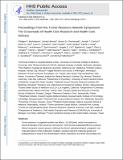| dc.contributor.author | Backeljauw, Philippe F. | |
| dc.contributor.author | Bondy, Carolyn | |
| dc.contributor.author | Chernausek, Steven D. | |
| dc.contributor.author | Cernich, Joseph T. | |
| dc.contributor.author | Cole, David A. | |
| dc.contributor.author | Fasciano, Laura P. | |
| dc.contributor.author | Foodim, Joan | |
| dc.contributor.author | Hawley, Scott | |
| dc.contributor.author | Hong, David S. | |
| dc.contributor.author | Knickmeyer, Rebecca C. | |
| dc.contributor.author | Kruszka, Paul | |
| dc.contributor.author | Lin, Angela E. | |
| dc.contributor.author | Lippe, Barbara M. | |
| dc.contributor.author | Lorigan, Gary A. | |
| dc.contributor.author | Maslen, Cheryl L. | |
| dc.contributor.author | Mauras, Nelly | |
| dc.contributor.author | Pemberton, Victoria L. | |
| dc.contributor.author | Prakash, Siddharth K. | |
| dc.contributor.author | Quigley, Charmian A. | |
| dc.contributor.author | Ranallo, Kelly C. | |
| dc.contributor.author | Reiss, Allan L. | |
| dc.contributor.author | Sandberg, David E. | |
| dc.contributor.author | Scurlock, Cindy | |
| dc.contributor.author | Silberbach, Michael | |
| dc.contributor.author | Page, David C | |
| dc.date.accessioned | 2017-06-15T20:16:59Z | |
| dc.date.available | 2017-06-15T20:16:59Z | |
| dc.date.issued | 2015-04 | |
| dc.date.submitted | 2015-01 | |
| dc.identifier.issn | 1552-4825 | |
| dc.identifier.uri | http://hdl.handle.net/1721.1/109921 | |
| dc.description.abstract | Turner syndrome, a congenital condition that affects ∼1/2,500 births, results from absence or structural alteration of the second sex chromosome. There has been substantial effort by numerous clinical and genetic research groups to delineate the clinical, pathophysiological, cytogenetic, and molecular features of this multisystem condition. Questions about the molecular-genetic and biological basis of many of the clinical features remain unanswered, and health care providers and families seek improved care for affected individuals. The inaugural “Turner Resource Network (TRN) Symposium” brought together individuals with Turner syndrome and their families, advocacy group leaders, clinicians, basic scientists, physician-scientists, trainees and other stakeholders with interest in the well-being of individuals and families living with the condition. The goal of this symposium was to establish a structure for a TRN that will be a patient-powered organization involving those living with Turner syndrome, their families, clinicians, and scientists. The TRN will identify basic and clinical questions that might be answered with registries, clinical trials, or through bench research to promote and advocate for best practices and improved care for individuals with Turner syndrome. The symposium concluded with the consensus that two rationales justify the creation of a TRN:
1. inadequate attention has been paid to the health and psychosocial issues facing girls and women who live with Turner syndrome; 2.
investigations into the susceptibility to common disorders such as cardiovascular or autoimmune diseases caused by sex chromosome deficiencies will increase understanding of disease susceptibilities in the general population. | en_US |
| dc.description.sponsorship | Eunice Kennedy Shriver National Institute of Child Health and Human Development (U.S.) (Grant 1R13HD079209-01) | en_US |
| dc.description.sponsorship | March of Dimes Birth Defects Foundation | en_US |
| dc.description.sponsorship | American Heart Association | en_US |
| dc.description.sponsorship | National Institutes of Health (U.S.) Office of Women's Health | en_US |
| dc.description.sponsorship | Leaping Butterfly Ministry | en_US |
| dc.description.sponsorship | Turner Syndrome Society of the United States | en_US |
| dc.language.iso | en_US | |
| dc.publisher | Wiley Blackwell | en_US |
| dc.relation.isversionof | http://dx.doi.org/10.1002/ajmg.a.37121 | en_US |
| dc.rights | Creative Commons Attribution-Noncommercial-Share Alike | en_US |
| dc.rights.uri | http://creativecommons.org/licenses/by-nc-sa/4.0/ | en_US |
| dc.source | PMC | en_US |
| dc.title | Proceedings from the Turner Resource Network symposium: The crossroads of health care research and health care delivery | en_US |
| dc.type | Article | en_US |
| dc.identifier.citation | Backeljauw, Philippe F. et al. “Proceedings from the Turner Resource Network Symposium: The Crossroads of Health Care Research and Health Care Delivery.” American Journal of Medical Genetics Part A 167.9 (2015): 1962–1971. | en_US |
| dc.contributor.department | Massachusetts Institute of Technology. Department of Biology | en_US |
| dc.contributor.department | Whitehead Institute for Biomedical Research | en_US |
| dc.contributor.mitauthor | Page, David C | |
| dc.relation.journal | American Journal of Medical Genetics Part A | en_US |
| dc.eprint.version | Author's final manuscript | en_US |
| dc.type.uri | http://purl.org/eprint/type/JournalArticle | en_US |
| eprint.status | http://purl.org/eprint/status/PeerReviewed | en_US |
| dspace.orderedauthors | Backeljauw, Philippe F.; Bondy, Carolyn; Chernausek, Steven D.; Cernich, Joseph T.; Cole, David A.; Fasciano, Laura P.; Foodim, Joan; Hawley, Scott; Hong, David S.; Knickmeyer, Rebecca C.; Kruszka, Paul; Lin, Angela E.; Lippe, Barbara M.; Lorigan, Gary A.; Maslen, Cheryl L.; Mauras, Nelly; Page, David C.; Pemberton, Victoria L.; Prakash, Siddharth K.; Quigley, Charmian A.; Ranallo, Kelly C.; Reiss, Allan L.; Sandberg, David E.; Scurlock, Cindy; Silberbach, Michael | en_US |
| dspace.embargo.terms | N | en_US |
| dc.identifier.orcid | https://orcid.org/0000-0001-9920-3411 | |
| mit.license | OPEN_ACCESS_POLICY | en_US |
